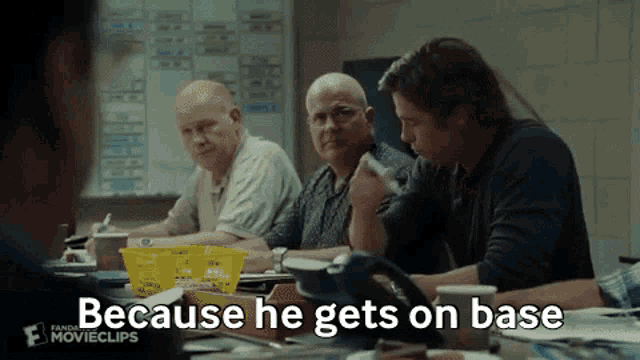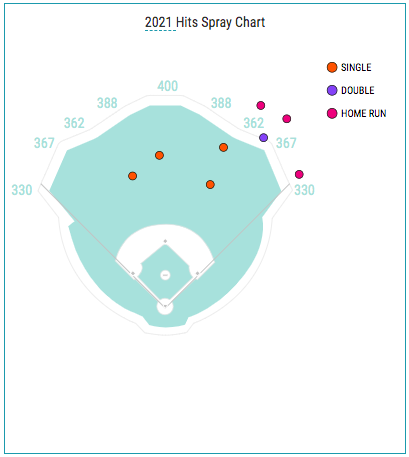This is a weekly column written for those who play in deeper dynasty formats, where I will be focusing on a player who is owned in less than 20 percent of Fantrax leagues – as that is the most commonly used platform for dynasty leagues.
This season—perhaps more than any in recent memory—will be about pop-up prospects. It has been well over a year since we last saw minor league baseball, and many previously unheralded prospects have been quietly developing behind the scenes. Some have made pitch mix or swing changes, and some have just simply gotten stronger or faster or better – which will give us prospect hounds and deep dynasty players a whole new slate of players to start paying attention to and speculatively adding in our fantasy leagues.
This weekly column will focus heavily on those pop-up guys throughout the summer, once we start seeing those changes put into action, because getting the jump on those players in deeper dynasty formats can be paramount in building a contending roster in future years.
However, while we wait for the minor leagues to get started, today’s article will instead focus on a completely different type of player in Oakland A’s 1B/OF Seth Brown, a 28-year-old former 19th-round pick who is off to an extremely hot start this season.
Has Billy Beane’s Moneyball mantra struck gold yet again, with the A’s finding a diamond in the rough, or is Brown more of a flash in the pan to begin the campaign? We will dive in more as the article goes on, but first a look at how we got here:
How Did We Get Here?
After a very stellar career at Lewis-Clark State College, one of the premier NAIA schools in the country, Seth Brown was selected in the 19th round of the 2015 MLB draft by the A’s. Standing six-foot-one and weighing 223 pounds, Brown had a stocky frame and a ton of thump in his bat, although even the most optimistic projections probably didn’t see him posting multiple 30-HR seasons in the minor leagues.
Brown began his pro career in Rookie Ball before getting a quick promotion to Low-A, where he slashed .289/.356/.431 with three home runs and six steals in 62 games played. He spent all of 2016 in High-A and although he only hit .241 with eight home runs in 532 plate appearances, he rocked an excellent 12.2% walk rate, scored 83 runs, and even tacked on 13 stolen bases – leading to a respectable 94 wRC+.
Brown repeated High-A in 2017 and that’s when the breakout really began. He mashed 30 home runs with 109 RBI and seven steals, slashing .270/.340/.506 with a 9.7% walk rate and a 25.2% strikeout rate – beginning to round into form as a “three true outcomes” slugger even while playing in the relatively neutral Midwest League.
2018 saw Brown’s power dip as he was promoted to the pitcher-friendly Texas League, but he still slashed a tidy .283/.342/.454 with a 116 wRC+.
Then came 2019, when Brown finally got a chance to hit in the notoriously hitter-friendly PCL – and with the juiced ball no less – and he took full advantage by blasting 37 home runs with 101 runs scored, 104 RBI, eight steals, and a .297/.352/.634 slash line in just 112 games played.
Yes, the PCL in 2019 is even worse than mid-90’s Coors Field, but those numbers are still very hard to ignore – especially coming from a 19th-round pick who already had a 30-HR minor league season under his belt.
That 2019 performance landed Brown in the big leagues, and he actually posted a nearly identical slash line (.293/.361/.453) but his power didn’t translate, as he had eight doubles and two triples in 75 at-bats, but no home runs.
Brown looked like a candidate to have a big role on the MLB club in 2020, but instead was held to just five plate appearances, pushing him pretty far off the radar heading into 2021 and his age-28 season.
However, after mashing six extra-base hits and drawing seven walks in 39 spring training plate appearances, Brown landed a spot on Oakland’s big league roster in 2021. Since then he has managed to hit his way into the starting lineup, forming the strong side of a platoon with Stephen Piscotty, which allows him to make the majority of the starts when the team is facing a right-handed pitcher. Brown is slashing .265/.342/.559 as of this writing, with a 158 wRC+, three home runs, six RBI, and a 10.5% walk rate along with a very respectable 23.7% strikeout rate.
So far, Brown has looked every bit the part of an Oakland pop-up prospect, showing really nice raw power while of course embodying the words of Jonah Hill’s character, Peter Brand, in the movie Moneyball:

Diving Deep
So far the early results in 2021 have been extremely encouraging for Seth Brown. His max exit velocity, a great barometer for a player’s raw power, is 112.4 miles per hour – just inside the 90th percentile.
Of course, Brown’s raw power potential wasn’t really in question, but seeing him finally start to leave the yard at the big league level has been encouraging, and the 44% hard hit rate, 36% sweet spot rate, and 16% barrel rate suggest a player who is impacting the ball extremely well to begin the campaign. In fact, Brown’s xSlash line is an extremely eye-popping .300/.385/.573, with a xWoBACON of .497.
Among the biggest differences in Brown’s profile is an emphasis on pulling the ball, which he is currently doing a whopping 64% of the time and still having success despite getting shifted on nearly 100% of the time.

Brown was always a pull hitter, and while this increased rate is likely contributing to his relatively pedestrian .273 BABIP, his overall .265 batting average is more than palatable for a player with his considerable power, and with his eye at the dish.
Brown has been much more selective at the plate this year, swinging just 38.8% of the time on the whole (down from 44.4% in 2019) with the drop even more pronounced on pitches in the zone (55.9% compared to 65.2% in 2019). This approach has always been a part of Oakland’s overall offensive strategy, and it can work quite well as long as the hitter doesn’t miss the pitches they are waiting for, and Brown’s 90.9% zone contact rate and very low 10.2% swinging strike rate – along with the aforementioned hard hit rate, barrel rate, etc. – suggest that he is getting the pitches he wants to hit, and doing what he wants to do with them.
Of course, avoiding left-handed pitching is no doubt helpful for the left-handed-hitting Brown, and indeed his platoon splits are quite striking throughout his career. Brown’s overall numbers against righties this season are excellent:
| BA | OBP | SLG | K | BB | wRC+ |
| .258 | .343 | .581 | 20% | 11.4% | 163 |
The sample is small, of course, but Brown looks like a slugger whose strong plate discipline has translated well to the big league level. He has found his pull-side pop at the big league level by being patient and taking advantage of good pitches and is drawing walks at a high rate while avoiding the massive strikeout issues that often plague high-OBP power hitters in today’s game.
But what does it mean for your fantasy league?
Fantasy Focus (A.K.A What can Brown do for you?)
Brown has a very prototypical Oakland profile: a left-handed hitting corner bat with good contact skills, an excellent walk rate, and some thump. Recent examples in Oakland include Daric Barton, Erubiel Durazo, Jack Cust, and a pair of stars from Moneyball—Jeremy Giambi and Scott Hatteberg—although Brown has considerably more raw power than all of those guys except Cust.
In fact, Brown looks a little bit like his current teammate, Mitch Moreland, who has made a nice career out of crushing right-handed pitching while hitting about 20 home runs with a 10% walk rate year after year.
Expecting Brown to turn in a Moreland-esque career is probably a bit too ambitious, especially at his already advanced age, but three to four seasons that somewhat resemble Moreland’s peak years (18-20 home runs, 11% walk rate, .250/.340/.440 slash line) is entirely possible, and realistically the power could push closer to the 25-30 home run range if he draws the vast majority of starts for Oakland against right-handed pitching.
From a fantasy perspective, Brown’s value is higher in leagues that count OBP instead of batting average, although his history suggests he won’t drag you down too badly in the average department either – certainly not as bad as many other high-walk, high-power sluggers around the league.
At 28 years old, Brown’s dynasty value is not as impactful as some of the younger players this column has covered in the past, but as a late breakout candidate, he is certainly someone worth taking a flyer on in deeper dynasty (and redraft) leagues, particularly formats that count OBP and allow daily lineup changes, since Brown is only pencilled into the starting lineups against right-handed pitching.
Dynasty leagues should know this is not a long, long term play, but picking up a guy who is free on the waiver wire in well over 80% of leagues who can contribute in multiple categories for the next few years is hardly a gamble worth passing on, particularly for those who can switch him out on a daily basis.
Those in redraft formats should take a strong note here as well, as Brown’s performance throughout the season could easily merit rostering in 14+ team leagues and maybe even 12-teamers for those in need of some extra thump and can’t afford to take a hit in batting average or on-base percentage.
Featured image by Justin Paradis (@JustParaDesigns on Twitter)


Good call out. I was totally overlooking him. Have to see if there’s room for him on my 12 team bench. Platoon players don’t make good subs (you want them to answer the call when a starter has a day off) so, in order to be worth a spot, he’d have to actually be good enough to be a starter when he plays, with a sub for HIS off-days.